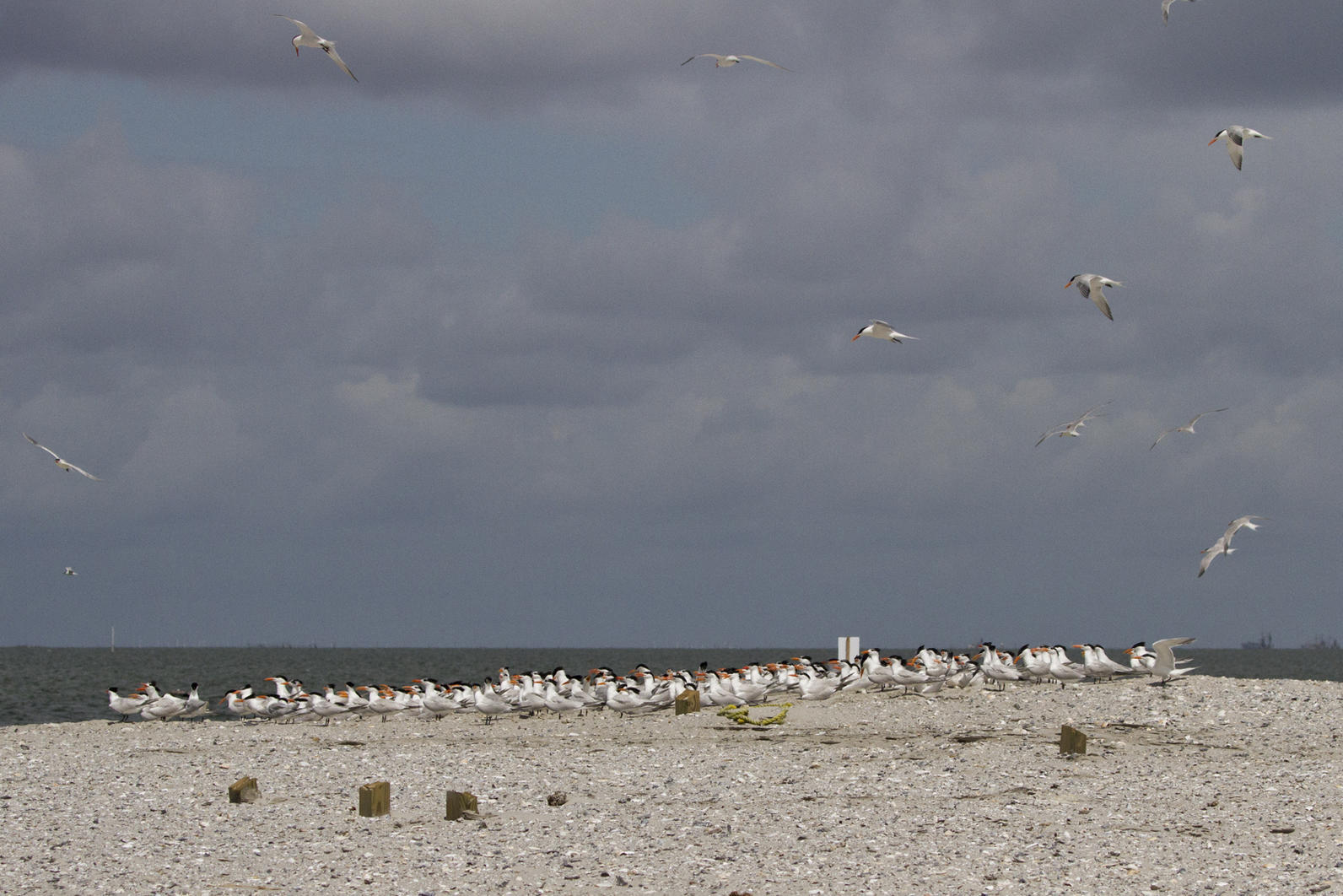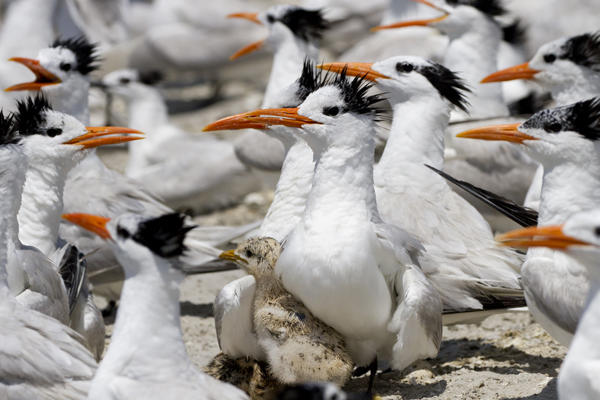Q: What's the best spot for birding on the coast?
A: There are many great places to go birding along the North Carolina coast. One of the best way to find sites near you is to visit the North Carolina Birding Trail's website. Here are three favorites:
South coast: Wrightsville Beach - Visit the south end of the island (at Masonboro Inlet) between April and August to see beach-nesting species like the Black Skimmer, American Oystercatcher, and Least Tern, and visit the north end of the island (at Mason Inlet) year-round to see beach-nesting birds as well as flocks of migrating and wintering shorebirds, including the Piping Plover, Black-bellied Plover, and Dunlin.
Mid-coast: Rachel Carson Reserve - Part of the National Estuarine Research Reserve System, the Reserve has two trails and opportunities to see species including the White Ibis, Wilson's Plover, and Painted Bunting. Flocks of Black Skimmers gather on shoals during fall migration. The best time to visit is around low tide, when shorebirds feed on exposed tidal flats. The Reserve is also not far from ferries to Cape Lookout National Seashore, another excellent coastal birding destination.
North coast: Pea Island National Wildlife Refuge - A haven for wintering waterfowl, including the Snow Goose and Tundra Swan, Pea Island offers excellent birdwatching opportunities year-round. In the late summer and early fall, look out for migrating terns, including the Black Tern and Caspian Tern.
Q: I love spending time on the beach, and I want to help birds! Do you have a volunteer program?
A: There are a number of ways to get involved with Audubon North Carolina on the coast! You can join our local Cape Fear Audubon chapter, which serves Brunswick, Pender, New Hanover, and Onslow counties: see their calendar for opportunities to get involved. You can also volunteer with the Wrightsville Beach Bird Stewards, a volunteer crew that educates visitors about beach-nesting birds on the south end of Wrightsville Beach.
Q: Why should I not feed the gulls at the beach?
A: Feeding birds can lead to an unnaturally higher number of gulls or crows, which are species that prey on other birds’ young and eggs, including Piping Plovers, Black Skimmers, and terns. It can also create behavioral problems in the birds, which can lose their fear of humans and become aggressive.
Q: I saw a rare or unusual species. Who do I report it to?
A: Sometimes species that don't normally occur in an area show up anyway (see the last question on this page for more). You can always contact our staff to share or confirm your interesting find, but the best place to report such sightings to is eBird.org, an online citizen science portal for birdwatchers to log their findings. Scientists can then investigate many questions about bird distribution and movements through eBird's data.
A word of caution though: If a bird is truly rare and out of range, it may already be stressed or in trouble. So, it's always a good idea to consider if reporting it right away will draw too much attention from wildlife enthusiasts who might inadvertently disturb the bird in attempts to view it. If possible, wait before spreading the news of your sighting. For example, in some winters Snowy Owls appear on our coast. These are extremely charismatic birds that attract a lot of attention! Unfortunately, this also means people approach too closely. If disturbed frequently enough, the bird can be prevented from hunting and resting normally- something those same wildlife enthusiasts surely don't want!
Q: Can I take a boat out to islands where birds are nesting?
A: Most islands that host nesting birds are closed to landing during the nesting season (March 1 - Sept 15) in order to protect them from human disturbance. Look for white or yellow signs marking these no-entry areas. It is possible to paddle or motor around nesting islands and view birds from a safe distance, however if birds respond to you in any way--by flying up, pacing at the shore, or otherwise acting agitated--you are too close and should back up in order to avoid stressing parents and causing harm to eggs or chicks.

Q: Do birds drink salt water?
A: Many seabirds, such as pelicans, have glands which filter salt, allowing them to drink salt water!
Q: How do birds nest on the beach?
A: Most birds that nest in beach habitats nest directly on the sand. They make a simple bowl-like depression called a "scrape" which serves as their nest. Because surface temperatures can often exceed 100F, they spend much of their time shading eggs and young chicks, making them vulnerable to human disturbance. See our FAQ below, "Why are parts of the beach roped off for birds in the summer?" to better understand how we can share the beach with birds while they are nesting and raising young chicks!
Q: I found a dead bird. What do I do?
A: If you find a dead bird, it's always a good idea to check its legs for bands (see following question for more information about banded birds). In most cases, nothing else is necessary because there is no general clearing house for collecting such information. However, if you have any questions or concerns about the circumstances, you can always contact our staff for further advice and referral to the correct agencies.
Q: Why do some of the birds I see have bands around their legs?
A: Banding birds--placing lightweight metal or plastic rings around birds' legs--is a common practice among researchers who want to learn more about a species' demography and movements. By resighting banded individuals, they can learn where birds go, how long they live, and a lot more.
Some bands will have a unique sequence of engraved letters or numbers that identify that individual, while others will have several unmarked bands whose unique color combination identify the bird. Some bands, usually brightly colored bands, are meant to be read with a spotting scope or binoculars, and others are usually only legible if the bird is found dead or recaptured--so if you find a dead bird, check its legs for bands.
You can report any species of banded bird to the Bird Banding Lab, and banded America Oystercatchers here. Make sure you note where you found it, the date, the color of the band, and the code on the band. Including a photo of the banded bird is almost always helpful.
Q: Why are parts of the beach roped off for birds in the summer?
A: Like all parents, nesting birds are sensitive to disturbance that diverts their attention away from caring for eggs or young. At the beach, human recreational activities can easily impact birds. Therefore, nesting areas are roped off during the breeding season (usually April through August) in order to create a safe buffer between hard-working bird parents and sources of disturbance.
When a threat (such as humans or dogs) is too close, adult birds take flight to mob the perceived attacker or to flee the danger. This leaves eggs and chicks unprotected and vulnerable on many fronts. Being left unshaded by a parent for even a short time can cause temperature stress that kills eggs or chicks, and without a parent nearby, predators like gulls and crows can swoop in. Of course, direct harm is also possible, such as people stepping on well-camouflaged eggs or chicks, or dogs chasing adults or chicks. Finally, chronic disturbance from human recreation or other sources can cause parent birds to abandon eggs or chicks. Protecting nesting areas provides birds with safe habitat to nest in and offers opportunities for people to view wildlife at the beach!

Q: Why am I seeing [Brown Pelicans, American Oystercatchers, Royal Terns, etc.] this time of year, shouldn't they be migrating?
A: Although your bird book might tell you that some species shouldn't be present in your region during a certain season, there are often exceptions to the rule. Therefore, field guides and natural history accounts provide a general description of birds' migrations.
Particular individuals might be out of place for a variety of reasons: they might not be fit enough to migrate; they might be young birds that are waiting until they have another year of experience under their belts before undertaking a long, hazardous migration; they might have been blown off-course by a storm or other weather event; they might simply have lost their way; or they might be early or late migrants, arriving or departing a little out of step with the norm for their species. Additionally, species sometimes gradually shift their ranges. For example, Wood Storks are expanding their nesting range northward and are now annual nesters in North Carolina.






